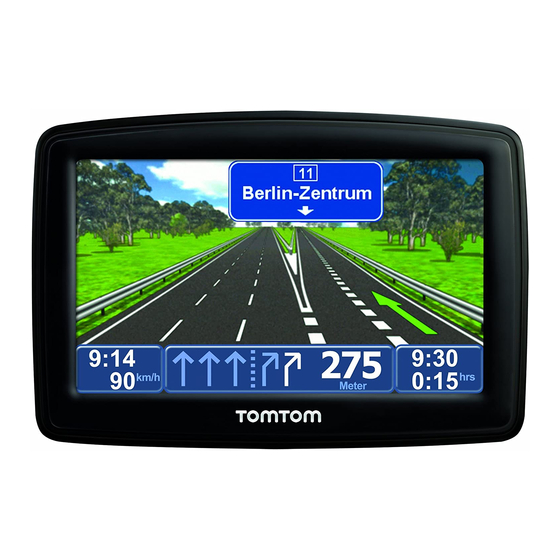TomTom One XL 참조 매뉴얼 - 페이지 37
{카테고리_이름} TomTom One XL에 대한 참조 매뉴얼을 온라인으로 검색하거나 PDF를 다운로드하세요. TomTom One XL 40 페이지. Tomtom xxl 550m: reference guide
TomTom One XL에 대해서도 마찬가지입니다: 매뉴얼 (2 페이지), 설치 매뉴얼 (1 페이지), 사용자 설명서 (40 페이지), 매뉴얼 (43 페이지), 매뉴얼 (34 페이지), 사용자 설명서 (11 페이지), 사용자 설명서 (38 페이지)

AU:www.tomtom.com/8703, CZ:www.tomtom.com/7509, DE:www.tomtom.com/
7508, DK:www.tomtom.com/9298, ES:www.tomtom.com/7507,
FI:www.tomtom.com/9299, FR:www.tomtom.com/7506, HU:www.tomtom.com/
10251, IT:www.tomtom.com/7505, NL:www.tomtom.com/7504,
PL:www.tomtom.com/7503, PT:www.tomtom.com/8029, RU:www.tomtom.com/
10250, SE:www.tomtom.com/8704, UK:www.tomtom.com/7502,
US:www.tomtom.com/7510
SPECIAL NOTE REGARDING DRIVING IN CALIFORNIA AND MINNESOTA
California Vehicle Code Section 26708 (a) (1) provides that "No persons shall drive any
motor vehicle with an object or material placed, displayed, installed, affixed or applied
upon the windshield or side or rear windows." Drivers in California should not use a suc-
tion mount on their windshield, side or rear windows.
Note: this section of the California Vehicle Code applies to anyone driving in California, not
just California residents.
Minnesota State Legislature Statutes Section 169.71, subdivision 1, section 2 provides that
"A person shall not drive or operate with any objects suspended between the driver and
the windshield other than sun visors and rearview mirrors and electronic toll collection
devices."
Note: this Minnesota Stature applies to anyone driving in Minnesota, not just Minnesota
residents.
TomTom Inc. bears no responsibility for any fines, penalties or damage that may be incur-
red by disregarding this notice. While driving in any state with windshield mounting res-
trictions, TomTom recommends the use of the supplied Adhesive Mounting Disk or its
Alternative Mounting Kit, which includes multiple options for mounting TomTom devices
on the dashboard and using the air vents. See tomtom.com for more information about
this mounting option.
FCC Information for the User
This product contains a transmitter which must not be co-located or simultaneou-
sly operated in conjunction with any other transmitter.
Exposure to Radio Frequency Radiation
This device complies with FCC radiation exposure limits set forth for an uncontrolled envi-
ronment. In order to avoid the possibility of exceeding the FCC radio frequency exposure
limits, human proximity to the antenna shall not be less than 8 inches (20 cm) during nor-
mal operation.
Radio and Television Interference
This equipment radiates radio frequency energy and if not used properly - that is, in strict
accordance with the instructions in this manual - may cause interference to radio commu-
nications and television reception.
This device has been tested and found to comply with the limits for a Class B digital
device, pursuant to Part 15 of the FCC Rules. These limits are designed to provide reaso-
nable protection against harmful interference in a residential installation. This equipment
generates, uses and can radiate radio frequency energy and, if not installed and used in
accordance with the instructions, may cause harmful interference to radio communica-
tions. However, there is no guarantee that interference will not occur in a particular ins-
tallation. If this equipment does cause harmful interference to radio or television
reception, which can be determined by turning the equipment off and on, the user is
encouraged to try to correct the interference by one or more of the following measures:
• Reorient or relocate the receiving antenna.
• Increase the separation distance between the equipment and the receiver.
• Connect the equipment into an outlet on a circuit different from that to which the recei-
ver is connected.
37
